Lighthouses
The rocky and deeply indented coast of Maine can be treacherous for ships. To keep shipping on course and away from the many hazards, Maine has an extensive network of lighthouses. Even if you are not fond of lighthouses, a trip to Maine must include a few of them. For enthusiasts Maine is utopia but be warned that you could end up with a serious case of lighthouse burn-out!
Dyce Head Lighthouse near Castine
Dyce (or Dice) Head is in Penobscot Bay just south of the town of Castine. This is a lighthouse that has come back from the dead. Built in 1829, the lighthouse was replaced in 1935 by a light on a metal tower close to the shore. In 1956 the town of Castine bought the old lighthouse and when we visited in 1998 the tower was undergoing restoration and was covered in scaffolding. The keeper’s house suffered significant damage in a fire the following year, but the tower escaped damage. The town voted to repair the keeper’s house, retaining as much of the original structure as possible. In September 2007 the metal tower of the 1935 light was knocked over in a storm resulting in a decision to reinstall a light in the original tower, bringing it back in service after a gap of 72 years. This 2013 picture shows the operational lighthouse and repaired keeper’s house. Dyce Head Lighthouse is not open to the public. The keeper’s house is now a rental cottage that provides income to the town to help to maintain the lighthouse.
Bass Harbor Head Lighthouse
This lighthouse stands in Acadia National Park at the southern tip of Mount Desert Island. The light sits atop the original 10 metre (32 foot) high brick tower that was built in 1858. The grounds of the lighthouse are open to the public, but the lighthouse remains in use and hence the tower is not open. The 1958 keeper’s house is now a private residence.
Portland Head Light with Ram Island Ledge Lighthouse in distance
Portland Head Light guides shipping into the main channel into Portland Harbor. In 1787 the Massachusetts legislature approved a budget of $750 to begin construction of a lighthouse at the mouth of Casco Bay. In 1790, the US Government took over the responsibility of all lighthouses and Congress appropriated $1,500 the completion of Portland Head Light and a keeper’s cottage. The tower housed 16 whale oil lamps which were first lit on January 10, 1791. In 1865 the tower was raised in height and a 2nd order Fresnel lens was installed in order to improve visibility of the light. The current two storey keeper’s house was built in 1891 and it was home to the head and assistant keepers until the light was automated in 1989. In the background of the picture is Ram Island Ledge Lighthouse which was built in 1905 and automated in 1959. It is now solar powered. Portland Head Light remains in active service managed by the US Coastguard but the grounds and keeper's house are now owned by the town of Cape Elizabeth, forming part of Fort Williams Park. The keeper's house is now a museum and shop. Click Tab 2 for a closer view of Ram Island Ledge Lighthouse.
Owls Head Light Station
Owls Head guards the approach to Rockland Harbor. The first light station was built here in 1825 but come 1852 it had to be rebuilt. Because it stands in a high headland, a tall tower is not needed. The tower is just 9 metres (30 feet) high. In 1854 a keeper’s house was built below the headland, at one time connected to the lighthouse by a covered walkway. Owls Head was automated in 1989, but the former keeper’s house continued to be used as a Coastguard residence until 2007. It now serves as the headquarters of the American Lighthouse Foundation. Owls Head Light Station was restored to its 1852 appearance in 2010. There is an interpretive center in the keeper’s cottage and the lighthouse is open in season.
Click on Minimap to navigate
Home > US States > New England > Maine >
Pemaquid Point Lighthouse
Pemaquid Point Lighthouse was built in 1835 to replace one built in 1827 that was in danger of collapse. Clearly the new one was rather better built than the first as it is still standing today. The tower of the present lighthouse is only 11.5 metres (38 feet) high but it is located high on a cliff to give it the necessary range. Click Tab 2 to see the Oil House by the lighthouse and the view out to sea.
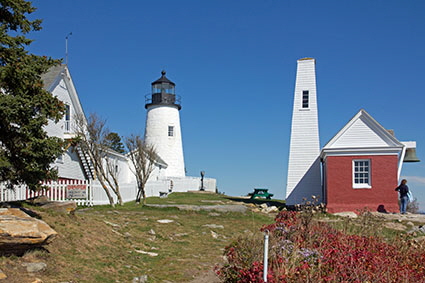
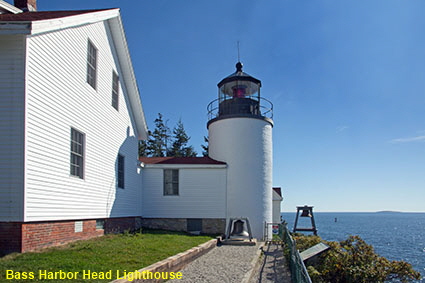
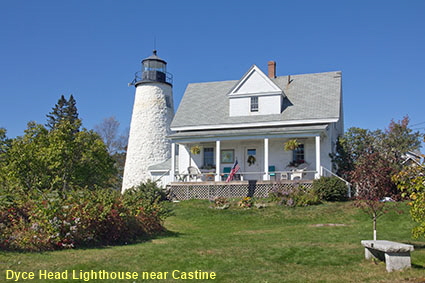
DLU180314


To move forwards or backwards through the Maine trail click the arrows above, or select your next destination on the Minimap.
West Quoddy Head Light Station, near Lubec
This is nearly as far as you can go along the coast of Maine, it is the easternmost point of the US mainland. Yes, there is an East Quoddy Lighthouse, but it is in Canada! The town of Lubec, Maine is separated from Canadian Campobello Island by he Quoddy Narrows. This is the only route into Passamaquoddy Bay via US waters and navigation is hazardous due to hidden rocks. Congress authorised the construction of a lighthouse on West Passamaquoddy Head in 1806. A wooden tower was built and it went into service in 1808. By 1831 the wooden tower had deteriorated, so a rubblestone tower was built to replace it. The new tower was not well built and was poorly lit, so in 1856 the current tower was built and fitted with a third-order Fresnel lens. The light was automated in 1988. West Quoddy Head Light Station is still in use as an aid to navigation but the former keeper's house now serves as a museum and visitor center. Tours to the top of the lighthouse tower are available at times during the summer.
Marshall Point Lighthouse & Keepers House
A rubblestone lighthouse with keeper’s house was built here in 1832 to mark the approach to the fishing village of Port Clyde. A new tower sited on the foreshore was completed in 1858, which was then connected to the land by a covered bridge. The keeper’s house was destroyed by a lightning strike in June, 1895. The current Colonial Revival house was completed in November the same year. The lighthouse was automated in 1971. The keeper’s house was used as a long range navigation station for a time, but by 1980 it had been boarded up. The town of St. George took a lease on the house and St. George Historical Society took responsibility for restoring it. The Marshall Point Lighthouse Museum opened in the former keeper’s house in 1990. The lighthouse appeared in a scene of the 1994 film ‘Forrest Gump’. The grounds of the lighthouse are open year round while the Marshall Point Lighthouse Museum is open between Memorial day and Columbus Day.
Rockland Breakwater Lighthouse
Just round the corner from Owls Head, Rockland Harbor is separated from Penobscot Bay by a long breakwater built to protect ships from northeasterly gales. The original light here was atop a wooden tripod on Jameson Point but as breakwater was built out from the point between 1881 and 1900 the tripod was moved four times to the end of the lengthening breakwater. The keeper had an ever longer walk as construction of the breakwater progressed to its final length of more than 1,200 metres (4,000 feet). In 1902 a keeper’s house with adjoining fog signal and lighthouse building was completed at the end of the breakwater. The light was automated in 1964 and from 1973 to 1989 a nearby resort looked after the buildings. The US Coastguard refurbished the buildings in 1990 then in 1999 ownership was transferred to the city of Rockland with the Coastguard retaining responsibility for the light. Volunteers now look after the lighthouse which they open to the public when resources permit. There is more about Rockland on our Mid Coast page.
Prospect Harbor Lighthouse from Prospect Harbor
Prospect Harbor sits on an inlet that is split in two by a promontory the end of which is marked by a lighthouse. The original lighthouse which went into service in 1842 comprised a granite keeper’s house with an integrated lighthouse tower. A fifth-order Fresnel lens was installed in 1857 but only two years later Congress decided to close the lighthouse because Prospect Harbor was ‘not used as a harbor of refuge’. The decision was reversed in 1870 and the lighthouse was lit once more. By 1889 the condition of the combined house and tower had deteriorated and were in need of replacement. The light was moved to a temporary wooden tower in 1891 allowing the old house and lighthouse to be demolished. A timber framed keeper’s house was built on the original foundations while a separate lighthouse tower was built of brick, initially connected to the house by a covered walkway. The light was automated in 1951. Prospect Harbor Lighthouse is now in the grounds of a US Navy satellite operations station and hence is not open to the public. In May 2000, the US Coastguard passed responsibility for thw lighthouse to the American Lighthouse Foundation.
Fort Point Lighthouse, Stockton Springs
While the lighthouse dates back only to the 19th century, this site has history from colonial times. In 1757 when Maine was still part of the Massachusetts Colony, Governor Thomas Pownall wrote to British Prime Minister William Pitt proposing that a fort should be constructed on the Penobscot River. The following year he built the fort on Wassaumkeag Point, the easternmost point of Cape Jellison. It was named Fort Pownall after the Governor. It was occupied by British forces until 1775 after which American forces destroyed the fort to prevent the British from re-occupying it. In 1834 Congress approved funds to build a lighthouse on the point, which had become known as Fort Point. The land on which the lighthouse was built was sold to the government by its first keeper, William Clewley. Completed in 1836, the lighthouse and keeper’s house could not have been well built because only six years later there were reports of serious defects in both. In 1857 both lighthouse and keeper’s house had to be replaced. In 1872 the luxury Wassaumkeag Hotel was built adjacent to the lighthouse. It did not make money and it burned down in 1898. Fort Point Lighthouse was automated in 1988 and is still in use. The keeper’s house is now the residence of the supervisor of Fort Point State Park. The park is open to the public daily but the house and lighthouse are private.
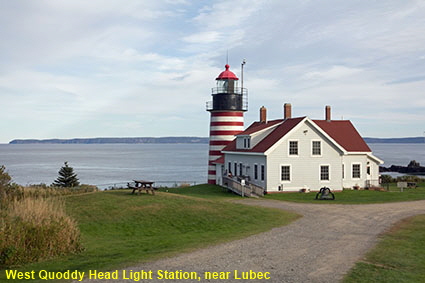
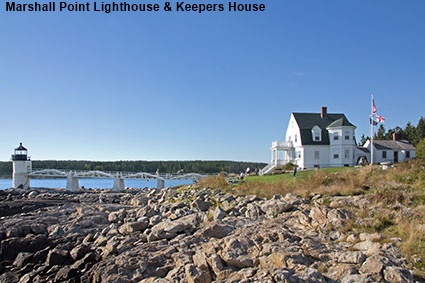
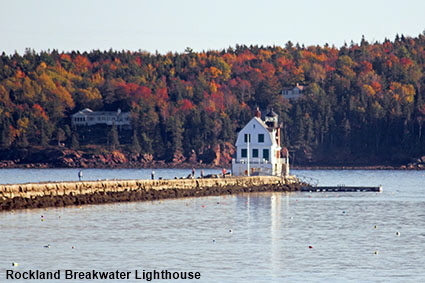
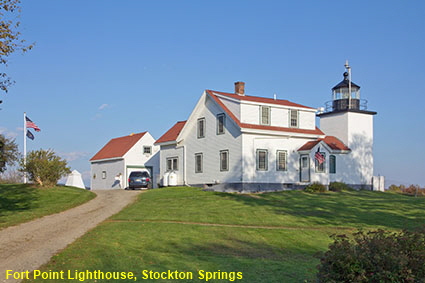
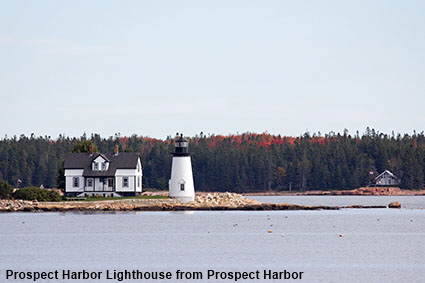
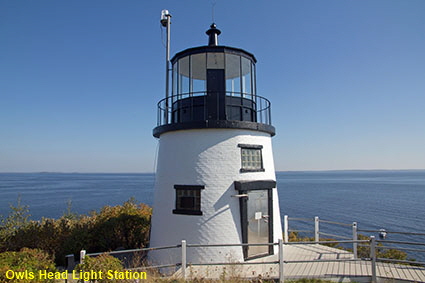
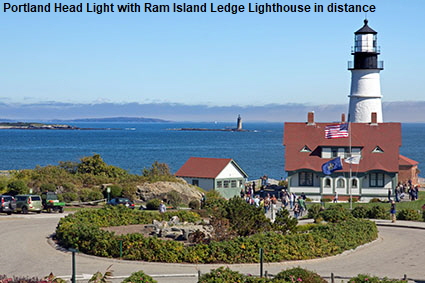
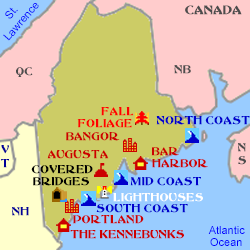

© Mike Elsden 1981 - 2025
The contents of this page may not be reproduced in full or in part without permission